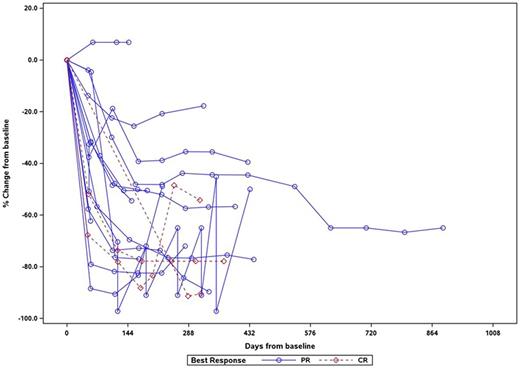Abstract
Introduction: Marginal zone lymphoma (MZL) is an indolent B-cell malignancy which comprises approximately 10% of non-Hodgkin's lymphomas. Copanlisib is an intravenously administered pan-Class I phosphatidylinositol 3-kinase (PI3K) inhibitor with predominant activity against PI3K-α and PI3K-δ isoforms. In the recent phase II CHRONOS-1 trial, treatment of patients with relapsed or refractory indolent B-cell lymphoma with copanlisib resulted in an overall response rate (ORR) of 59%. A total of 23 patients (16%) in the trial had MZL histology. We describe here a subset analysis of the MZL patients in CHRONOS-1 .
Methods: Patients enrolled into the CHRONOS-1 trial with MZL had to have relapsed after, or were refractory to ≥2 prior lines of treatment. Previous treatment had to include rituximab and an alkylating agent. Copanlisib was administered at a fixed dose of 60 mg via 1-hour I.V. infusion on an intermittent schedule days 1, 8 and 15 of a 28-day cycle. Treatment continued until progression or unacceptable toxicity. The subset analysis comprised 23 MZL patients (15 nodal, 4 splenic and 4 MALT lymphomas). Objective tumor response rate (ORR) after ≥4 cycles was assessed per independent radiologic review (Cheson et al., JCO 20:579, 2007). Secondary efficacy endpoints included duration of response (DOR). Adverse events were assessed using the CTCAE (v4.03) coding.
Results: The 23 MZL patients, as assessed by the investigator, included 4 (17.4%) mucosa-associated lymphoid tissue (MALT) lymphoma, 15 (65.2%) nodal MZL and 4 (17.4%) splenic MZL. Median age was 69 years (range 39-81) and ECOG status 0 and 1 roughly similar (52% and 48%). Prior treatment included a median of 3 (range 2-9) lines of therapy, with 48% being refractory to the last regimen, and 44% refractory to last rituximab regimen. As of the data cutoff date of 20 February, 2017, patients had received a median of 5.8 cycles of treatment with a median duration of treatment of 23 weeks (range 1-138).
A total of 16 patients had an objective tumor response, for an ORR of 70%. Complete responses (CR) were observed in 3 (13%) patients, all with splenic MZL. Twelve of 15 (80%) patients with nodal disease had an objective tumor response and 1 of 4 (25%) with MALT had a response. The median DOR had not been reached, with the range being 1-728 days and 85% estimated to be in response at 9 months. Individual plots of tumor shrinkage over time for responders indicated rapid and prolonged responses (See Figure). The most common treatment-emergent AEs (all grade/grade 3+) for the entire CHRONOS-1 study population were transient hyperglycemia (50.7%/41.5%) and hypertension (30.3%/23.9%). Other AEs included decreased neutrophil count (31.7%/25.4%), diarrhea (33.8%/5.6%), lung infection (24.6%/16%), pneumonitis (7%/2.1%), and colitis (0.7%/0.7%). Laboratory toxicities of interest were principally grade-1, including elevated ALT (24.1% all-grade/20.6% grade-1) and AST (30.5% all grade/27% grade 1-2). In the MZL subset, there were no non-fatal opportunistic infections and no deaths attributed to copanlisib. However, there were 3 treatment-related deaths in the total patient population of the CHRONOS-1 study.
Conclusions: Copanlisib treatment of relapsed or refractory MZL patients resulted in a promising ORR of 70% and CR rate of 13% in this cohort of 23 patients. Responses were durable, with the median DOR having not yet been reached (85% were estimated to be in response at 9 months), higher than what has been previously reported in the MZL treatment landscape, warranting further study of copanlisib in MZL.
Figure: Time course for tumor shrinkage (per investigator assessment) for individual MZL patients achieving an objective tumor responses (per independent central review) while receiving copanlisib treatment.
Dreyling: Sandoz: Consultancy; Roche: Consultancy, Honoraria, Membership on an entity's Board of Directors or advisory committees, Research Funding, Speakers Bureau; Bayer: Consultancy, Speakers Bureau; Celgene: Consultancy, Research Funding, Speakers Bureau; Gilead: Consultancy, Speakers Bureau; MorphoSys AG: Consultancy; Mundipharma: Consultancy, Research Funding; Janssen: Consultancy, Research Funding, Speakers Bureau. Santoro: Merck: Membership on an entity's Board of Directors or advisory committees; Bristol-Myers Squibb: Membership on an entity's Board of Directors or advisory committees. Ishida: Bayer SA: Employment. Lu: Bayer HealthCare Pharmaceuticals: Employment. Hiemeyer: Bayer AG, Pharmaceuticals Division: Employment. Garcia-Vargas: Bayer HealthCare Pharmaceuticals: Employment. Childs: 11. Bayer HealthCare Pharmaceuticals: Employment. Zinzani: Bayer: Honoraria, Membership on an entity's Board of Directors or advisory committees; Roche: Honoraria, Membership on an entity's Board of Directors or advisory committees; Celgene: Honoraria, Membership on an entity's Board of Directors or advisory committees; Gilead: Honoraria, Membership on an entity's Board of Directors or advisory committees; Johnson & Johnson: Honoraria, Membership on an entity's Board of Directors or advisory committees; Bristol-Myers Squibb: Honoraria, Membership on an entity's Board of Directors or advisory committees; Karyopharm Therapeutics: Honoraria, Membership on an entity's Board of Directors or advisory committees; Verastem: Honoraria, Membership on an entity's Board of Directors or advisory committees; Merck: Honoraria, Membership on an entity's Board of Directors or advisory committees; Servier: Honoraria, Membership on an entity's Board of Directors or advisory committees; Takeda: Honoraria, Membership on an entity's Board of Directors or advisory committees.
Author notes
Asterisk with author names denotes non-ASH members.


This feature is available to Subscribers Only
Sign In or Create an Account Close Modal